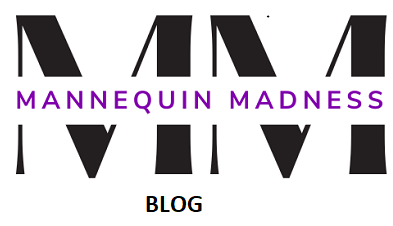v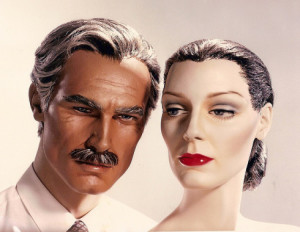 i.
i.
Rewind to the early 1950’s, when a young Adel Rootstein immigrated to London from South Africa (born in Warmbaths, 1930) to discover the city’s fashion scene in the midst of a glamorous post-WWII revival – a creative wave that would later make way for the likes of Mary Quant, Jean Muir, Ossie Clarke and Barbara Hulanicki’s BIBA.
As a window dresser at Aquascutum, Adel grew tired of the faceless forms that stared back at her from under the label’s elegant trench coats. What use were beautiful garments, she thought, if you have only bland and featureless dummies upon which to admire them? Unbeknownst to Adel this question, born of boredom, would dictate her life’s work.
(Note: This post is reprint a 2013 article from A Magazine Curated by… which is a fashion magazine that explores the universe of a chosen fashion designer in each issue)
“Adel lived and died in Jean Muir and Mary Quant,” exclaims Kevin Arpino of his late employer, who he describes as a glamorous fixture of the London fashion set, a woman whose personal sense of style and panache remains embedded in the lifeblood of the company. Note: here is the obituary of Adel Rootstein which goes into more detail about her life.)
As Adel’s successor after her death in 1992, Kevin has seen over three decades at Rootstein’s London and New York offices.
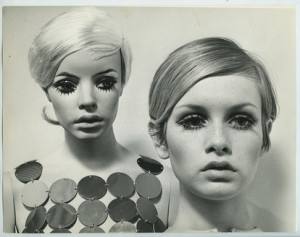
Twiggy and her mannequin by Rootstein
.
“Adel started her company making wigs for windows in her Earl’s Court apartment,” explains Kevin, ushering me through a hallway of partially painted faces above the company’s sleek salon showroom. “She was really breaking boundaries in those days. Her idea was to bring to life the models that were selling clothes in the magazines”.
The first model to be sculpted live by her lifelong employee John Taylor in 1968 was a girl called ‘Imogen’ – a slender, exotic figure whose significance has become somewhat lost amongst the bevy of top models Rootstein has since immortalized in fiberglass, plaster and oils. It was Twiggy who put Rootstein truly on the fashion map. “Having a mannequin made is good luck for a model,” says Kevin, “It’s slightly Dorian Gray I think. For us it is more about choosing people who epitomize the time”
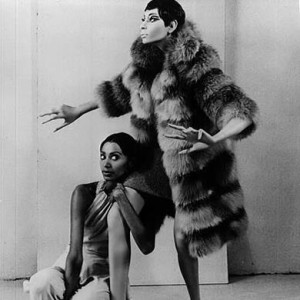
 .Michael and China Chow with an Adel Rootstein mannequin of Tina Chow in a printed chiffon evening dress by Zandra Rhodes, 1973
.Michael and China Chow with an Adel Rootstein mannequin of Tina Chow in a printed chiffon evening dress by Zandra Rhodes, 1973
Since Twiggy, countless beauties have stood before Rootstein’s sculptors (for hours and days at a time), their sizes and body shapes fluctuating with the trends – from Pat Cleveland, Violetta Sanchez and Joan Collins in the early days through to a young Naomi Campbell and Kate Moss and more recently the flame-haired Canadian beauty Coco Rocha.
Their replicas form series comprised of various figures and poses, which are then dressed and displayed for sale in the New York and London showrooms twice a year.
 Pat Cleveland mannequin
Pat Cleveland mannequin
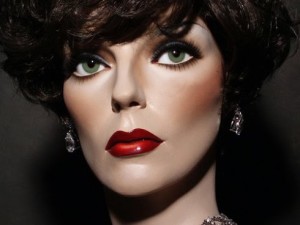 Joan Collins mannequin
Joan Collins mannequin
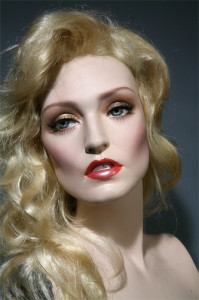 Jerry Hall mannequin
Jerry Hall mannequin
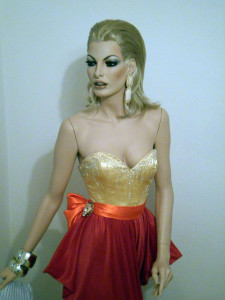 Linda Evangelista mannequin (comment from JP: the Linda Evangelista head is not by Rootstein. Linda was made by an artist/fan and placed on a Rootstein body)
.
Linda Evangelista mannequin (comment from JP: the Linda Evangelista head is not by Rootstein. Linda was made by an artist/fan and placed on a Rootstein body)
.
Aside from their famous faces, like any savvy fashion designer Rootstein have a commercial collection too – from mannequins with various heel heights to those in reclining or seated poses, glamorous gestural mannequins and more somber styles.
All must be considered when working with a solid, fixed form upon which to showcase the dynamic trends of any given era. “I think that the mannequin, when used properly, can give off a very strong image but unfortunately the people who know how to do that are a dying breed,” says Kevin, who labels the mannequin business as a ‘cottage industry’.
Even so, today Rootstein’s regular clients include designers from Tom Ford, Lanvin and Ralph Lauren to high street giants like Zara and department stores from Harvey Nichols to Bergdorf Goodman and the Galeries Lafayette. They’ve worked on exhibitions with the Costume Institute of the Met since the 70’s, including none other than Diana Vreeland’s iconic Yves Saint Laurent retrospective and her Ballets Russes show.
Photographers too have entertained a veritable love affair with Rootstein’s static beauties, a fact Kevin is quick to demonstrate with a wall of black and white photographs signed by the two legends. “Helmut Newton loved mannequins, and photographed many of ours. He was obsessed with them and used to collect them. Also David Bailey. We have made mannequins of all his wives!”
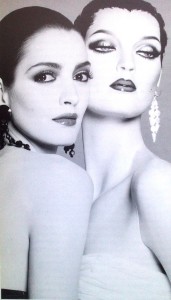
“The people who work here are artists, not makeup artists,” explains Kevin, of the team of six artisans in their makeup division who, under the watchful guise of head artists John Davis & Judith Fain, apply delicate oil paints to the finished mannequins in a four-day process which includes painting, drying, over-painting and eyelash application.
“You may get an order of fifty mannequins and have five artists doing the same makeup. John’s job is to make them all uniform, he’s what you call an overpainter.”
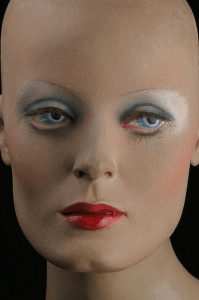
Rootstein mannequin for Biba
.In terms of styles and limitations, “We can do anything,” Kevin regales, “We’ve been inspired by Biba for decades – in fact the next season we’re doing very Biba petrol blue eyes. Actually Barbara (Hulanicki) came in here when she was working on her book recently. Adel originally did all the 1930’s heads for her shops. Barbara was fascinated, and so chuffed”.
Despite recent trends for faceless mannequins somewhat detracting from Rootstein’s demand for made-up faces, new commissions have had the division working overtime – including last year’s worldwide takeover of Louis Vuitton by the Japanese artist Yayoi Kusama, a project that saw the luxury house’s window displays overrun with white tentacles and mannequins (including one of the artist herself) covered in red polka dots.
“Every dot had to be in the right position. That was art, you know,” muses Kevin.
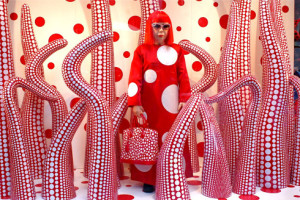
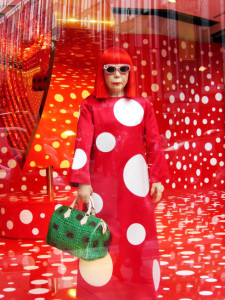
Yayoi Kusama mannequin for Louis Vuitton
.
Stephen Jones himself commissioned a bevy of busts and heads for an installation last November, when Mrs. Prada took over the Café Royal on London’s Regent Street for her 3-day women’s club called “The Miu Miu”. Charged with decorating the halls of the 3-level interior and one window (the second was offered to another British icon, Dame Vivienne Westwood), Stephen crafted three swirling vortex headpieces that grew out of glossy pink busts, each adorned with an assortment of Miu Miu’s sunglasses, bags and shoes.
For the window he turned Mrs. Prada’s skirts upside down as headdresses on the floating heads of Rootstein models like Erin O’Connor, Jade Parfitt and Yasmin Le Bon. “Three weeks before Stephen came in and said ‘You’re going to hate this dear, but what can you do?’” recalls Kevin.
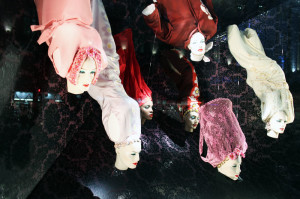
Stephen Jones for Café Royal, commissioned by Murcia Prada
.
“I just love the fact that Stephen is so hands-on,” he enthuses, winding up my tour by bestowing upon Mr. Jones a compliment that clearly reflects his own ardent dedication – not to mannequins or hats, or even fashion itself – but to the weird and wonderful labyrinth and the artisans over which he presides.
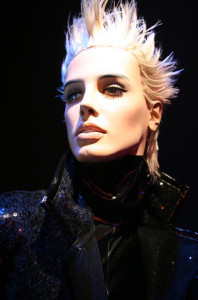
Agyness Deyn mannequin
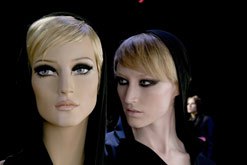
Jade Parfitt and her mannequinCoco Rocha and her mannequin .
